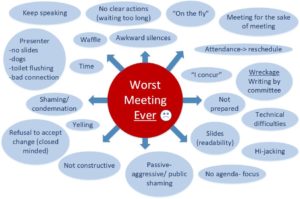Article
Bad Meetings and How to Make Them Better
Bad meetings can happen to good people. As someone who has hosted meetings about planning meetings, here are a few things to consider when organizing your own.

What makes a bad meeting? Here are some real-world examples direct from a local boardroom during a meeting about meetings. Yes, you read that right.
(Best of the) Worst Meeting Practices and How To Fix Them:
- Wrong room! Oops, the meeting has been moved but no one knew.
- Book your room early and be sure it will fit your needs so that you don’t have to make last-minute room changes.
- Think about the most convenient room setup. Classroom style or U-shape? This should facilitate the purpose of the meeting (presentation or discussion).
- Can you hear me? Can you please mute yourself? Tech issues!
- Whenever possible, do a dry run of the meeting in the room you plan to use. This should be done at least a day in advance, or at the very least an hour prior to the start of the meeting.
- Determine what meeting platform will best suit your needs. GoToMeeting and WebEx have different options depending on your needs.
- Where’s the coffee? Where’s the bathroom?
- Know your audience and their expectations, especially for longer meetings.
- Be familiar with the meeting room and surrounding area so you can direct attendees as needed.
- Place table tents with Wi-fi login instructions or include this info on the agenda or a slide and be sure there are power strips at the table to charge laptops and other devices.
- What’s the point?
- Focused agendas sent out in advance of the meeting are a plus to get everyone on the same page with expectations.
- Common goals are at the heart of why this meeting is needed and should be reflected in the agenda.
- Revisit the frequency of this meeting, or reaffirm the purpose as needed.
- Succinct visual presentations with large graphics and easy-to-read charts help engage audience.
- Free-for-all discussion gone wild! Meetings derailed by a select (loud) few.
- A respectable (and personable) chairperson should essentially emcee the show and be able to rein in those who dominate discussions or walk the tightrope of professionalism.
- Set time for Q & A opportunities to foster discussion and allow others to provide feedback.
- The eternal meeting…you know, that one that was supposed to end 10 minutes ago.
- Keep track of time! Monitor the clock and keep things moving.
- Follow up with attendees to recap meeting actions and provide a copy of presentation slides after the meeting.
More expert meeting planning resources:
A Quick Fix for Death by Power Point
Seven Steps to Running the Most Effective Meeting Possible
How to Run a More Effective Meeting






1 Comment
Also, expect the unexpected. Expect some people might wanted printed agendas, or pen/paper. Expect what files may be discussed and need to be presented on WebEx/slides.